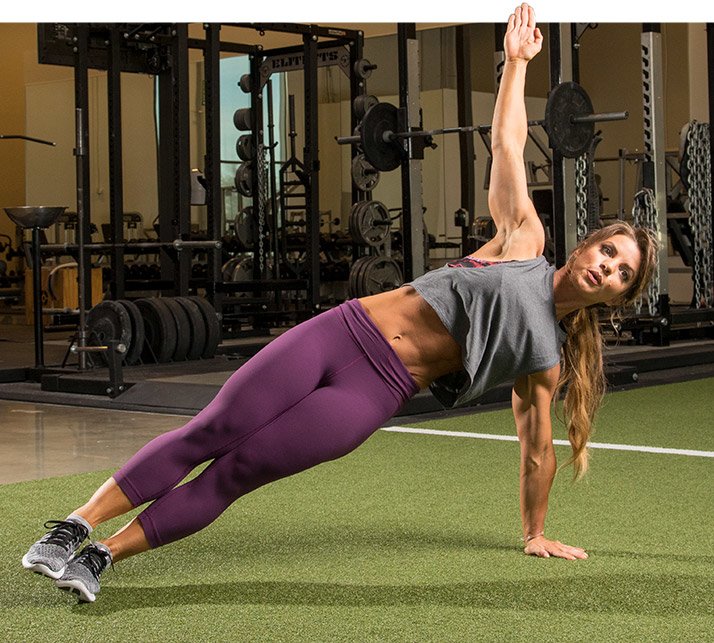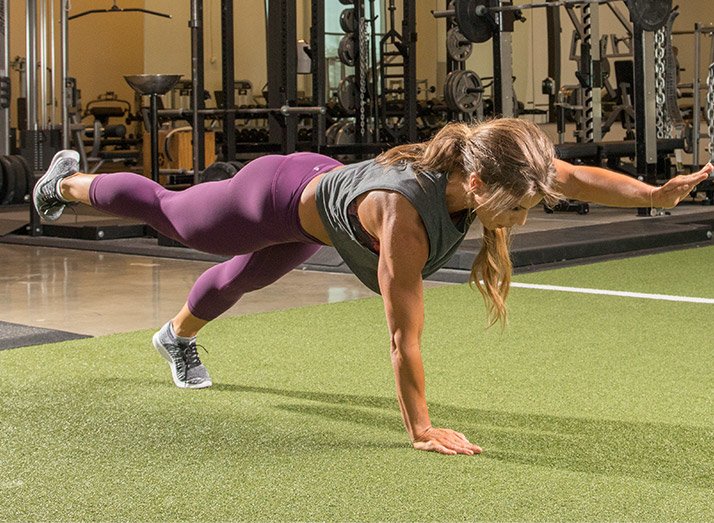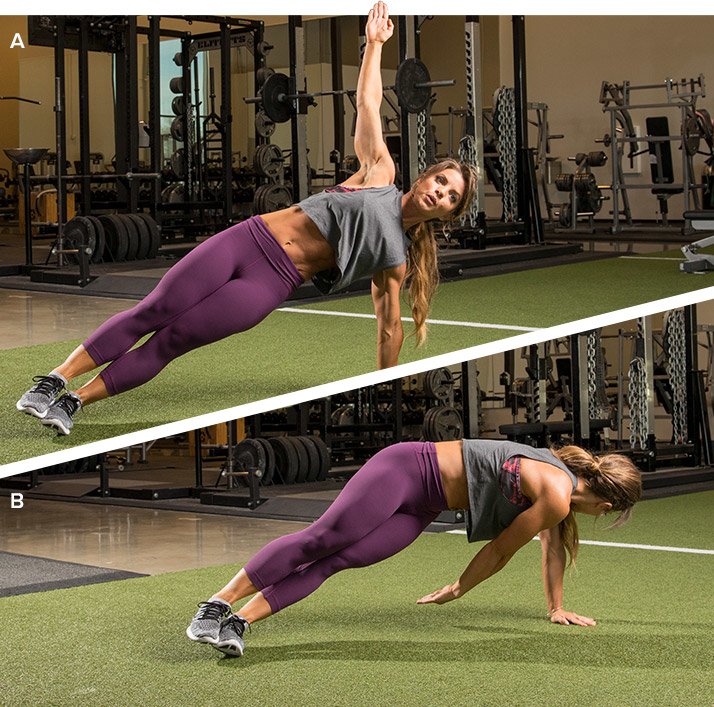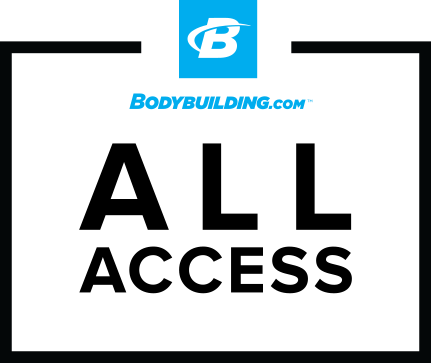
5 Ways To Make Your Planks Harder And More Effective!
Planks are more than just a static hold. Learn different variations on this core-burning exercise to challenge your entire body.
We've all probably done a plank or two before, right? Whether you're aiming for a 1-minute hold or challenging yourself in the fully elevated position, a static plank can get a bit dull after a while.
Don't get me wrong, I'm a huge fan of planks—and their modifications. These exercises are incredibly effective for overall core strength and can help to improve your posture. As a bonus, they can work your entire body, depending on what type of plank you do. This all sounds a lot more fun than just a static hold, doesn't it?
I love to switch things up with my workouts. I often take the most basic version of an exercise—in this example, a plank—and then add another element. Doing so provides a fun new challenge, keeps my body guessing, and expands my exercise repertoire.
Before you try these variations, a note of caution: Make sure you have your form down on both elbow and fully extended planks first. You want to feel confident with those moves before kicking things up a notch.
1. Plank Up/Downs
I love adding this exercise in as a cardio burst between sets when I'm strength training. It's especially good for an extra challenge on an upper-body day. Not only does this movement elevate your heart rate, it also works your chest, shoulders, back, and triceps (along with your core, of course).

Plank Up/Downs
How to Do It
- Begin in the fully-extended plank position, and then lower one arm at a time into elbow-plank position.
- Pause for 1 second in the elbow-plank position, and then (again, one arm at a time) push your way back up to fully extended plank position.
- Repeat this up/down sequence for 30-60 seconds. This should be a quick motion, where you're aiming to get from elevated to elbow plank and back up in a quick "1, 2, 3, 4" count before going back down again.
Tip: Your hips shouldn't rotate when you're moving up and down. The key is to keep your glutes tight and maintain a neutral spine throughout the motion, even though you're going from hands to elbows. Your upper body should be the only thing making swift movements.
2. Plank Jacks
Ah, the plank jack—such a fun hybrid of planks and those jumping jacks I despised having to do back in my PE class during junior high. Should be fun, right? You're getting a cardio burst workout while working your lower body (think glutes firing on each movement). You're also engaging your chest, shoulders, back, triceps, and many stabilizer muscles with every single rep.
There are a few ways to do these, and honestly, they pretty much come down to personal preference, pre-existing injuries, and just how high-impact you'd like to make the "jack" motion of your plank. Adding these in toward the end of an upper-body workout (between sets of chest or shoulder exercises especially) serves as an extra challenge and bonus burnout exercise for upper body.

Plank Jacks
How to Do It
- If you're brand new to these, begin in an elbow-plank position. If you're intermediate or advanced, do these in the full-plank position. You'll feel a bit less impact on your upper body than if you chose to do the fully extended plank.
- Instead of jumping both legs out at the same time, walk your right leg out to the side, walk your left out to the side, and then bring both back in.
- Repeat this for the 30-60 seconds per set.
Tip: Keep your upper body stationary the entire time. Don't jump out with your arms as you do with your legs. Looking to make plank jacks even more challenging? Add a loop band right above or below your knees. This will challenge your glutes and stabilizer muscles even more!
3. Push-Up With Side-Plank Rotation
These are one of my absolute favorite bodyweight exercises! I love this combo so much that I'll even add it on days I'm at the gym, not just for workouts on the go. We all know how awesome push-ups are for overall strength, so combine a push-up with a side-plank rotation to work your entire body. I like to start with this combo on days I train chest, so I do this before I've fatigued my upper body with serious weight training.
You're literally getting in a total-body workout with this push-up to side-plank rotation combo. Your core is engaged, all of your upper body is working with each push-up, and your lower body is engaged even more when you're in that side-plank position. As a bonus, your heart rate will be more elevated during these movements than it would be in just a static plank.

Push-Up With Side-Plank Rotation
How To Do It
- Do one push-up, then rotate to a side plank.
- Do another push-up, and rotate to a side plank on the other side.
- Alternate sides for a full minute per set.
- Once 3-5 sets at a minute begins to feel easy, add in a push-up to side plank with leg raise.
Tip: If this combo sounds too crazy, begin from a modified push-up position on your knees. You can still perform a modified side-plank rotation from the knee position. Build your strength and coordination here, then work up to one, two, and three sets of the full push-ups to side-plank rotations.

4. Alternating Arm-and-Leg Raise From Plank
Here's another way to turn your plank into a total-body workout. I love to incorporate these into my core training for a great ab and lower-back workout. You'll improve your strength, balance, and coordination as you alternate extending one arm and one leg at the same time. Just remember to use opposite sides, or you may find balancing even more complicated.

Alternating Arm-and-Leg Raise From Plank
How to Do It
- Begin in an elevated-plank position, and extend your left arm straight forward at shoulder level.
- Extend your right leg straight back behind you, going no higher than hip level. Keep your abs and glutes tight.
- Repeat on the opposite side.
Tip: If you're new to this, begin in the elevated-plank position. Extend your left arm first, then lower it before extending your back right leg and lowering it. I often superset this exercise with a set of reverse crunches on a decline bench. I use it at the end of a workout when I'm concentrating on abs, or add it to an at-home yoga day.
5. Side Plank Rotation
Side planks are another fun challenge. You can perform these on your elbows or fully extended. As with the other plank variations, you'll be challenging your core but placing an extra emphasis on your obliques as you push through your elbow/forearm or the palm of your hand from the elevated position. Aside from serving as a challenge to your core, back, and obliques, this move works your glutes and inner thigh muscles. Win-win!

Side Plank Rotation
How to Do It
- Get in a plank position.
- Open your hips and shoulders to one side until you're in a side-plank position. Keep your hips up.
- Rotate back toward starting position, but continue to bring your top arm all the way through, reaching across the opposite side of your body.
- I'll do 30 seconds per side, switching from one side to the next without any rest in between. I'm able to knock out 3-4 full sets in under 5 minutes.
Jen Jewell's HIIT Plank Workout
I would not typically include all the planks listed above in one workout, as I think that would be a bit of a plank-palooza. Instead, here's a fun way to do a HIIT-style bodyweight workout at home while incorporating a few of the plank variations.
Perform one set of each exercise back-to-back for 30 seconds. Rest briefly (30-60 seconds) after completing one full round of the HIIT circuit below. Then repeat the circuit until you've completed 3-5 rounds.


